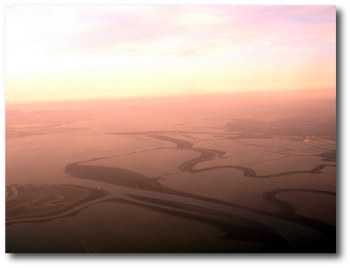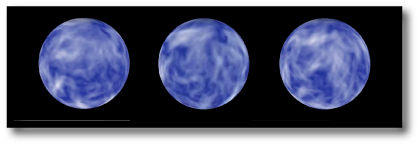
Image Source.
While talking to a reporter this morning, I ventured 1000:1 odds against Gl 581 “c” harboring a clement surface or a temperate ocean-atmospheric interface. Too bad we haven’t yet tapped into the galactic market — I’d like to hedge my bet with the purchase of an appropriate derivative security.
Habitable or not, Gl 581 c is pointing toward better worlds to come. As I remarked in the past two posts (1,2), we’re guessing that “c” formed beyond the snowline and migrated inward to its current position just outside the nebulous inner boundary of the habitable zone.
Here’s a 1.1 MB animation of Jonathan Langton’s simulation of the flow pattern on Gl 581 c. The clip shows 30 hours worth of weather on our model of the planet:

First a few technical details. We model the planet’s lower radiative stratosphere with a 2D compressible hydrodynamics code. We use a time-dependent model for radiative heating and cooling. The planet is assumed to be spin-synchronous, so that it rotates on its axis once every 12.9 days. The planetary mass is five-Earth masses (I’m holding out for a transit on May 7th!), and we take a radius of 1.7 Earth radii. The orbit is assumed circular, the luminosity of the star is 0.013 solar luminosities, and the planetary “Bond” albedo is assumed to be 55%. At the layer we’re modeling, we assume a molecular weight of 25, and an atmospheric column depth of 2500 kg/m^2. This corresponds to an atmospheric pressure at the troposphere-stratosphere interface of order 400 milli bar. We assume an equilibrium night-side temperature of 250K (as a result of heat welling up from beneath).
The animation shows the sub-stellar hemisphere. The weather on the planet rapidly reaches an equilbrium flow pattern with small windspeeds (of order 3-4 m/s). The temperature at the substellar point equilibrates at 330K.
In the deeper, convective layers of the atmosphere, we expect fierce thunderstorms to occur. In analogy with thunderstorms on Earth driving anvils into the stratosphere, we model the effect of the thunderstorms by supplying a random heating term to the stratospheric flow. We definitely welcome constructive criticism of this approach, since we’re neophytes in the exo-terrestrial planet climate business. For the technically inclined, here’s a .pdf write-up that details our radiation-hydrodynamical scheme (the example planet in the write-up is HD 80606b, rather than Gl 581c, but the numerical method is the same).
So what’s being plotted? We identified regions of higher wind speed with the formation of high water clouds (white) and regions of low wind speed with more transparent layers in which the spectrum of reflected starlight is controlled by Raleigh scattering (blue). The patterns in the atmospheric animation are thus controlled by atmospheric pressure waves and the random thermal variations driven by the thunderstorms, and not by actual advection of air.
It’s interesting to compare this with the animation of the (rotating) Earth taken by the Galileo probe as it flew by to pick up a gravity assist.

Interesting animation there – doesn’t look much like the Earth’s pattern, though to make a fairer comparison it might be interesting to see what the model outputs for a planet with Earth’s mass and rotation.
I wonder what the flow pattern would look like on Gliese 581 d (which, judging by the scaled habitable zone from Earth system to Gliese 581, I’d say looks much more likely to have reasonable surface temperatures), with an eccentric orbit and (perhaps) 3:2 rotation.
Pingback: Big News! An "Earth like" Exoplanet Is Out There. « DJ’ing, Music, Humour, Life
I’m curious how you chose the Bond albedo for these simulations. Would’t a water-rich atmosphere be very dark in the infrared, where most of the radiation from GJ 581 is? What’s so reflective about this planet in the infrared?
The emission from GL 581 should peak right around the visible/IR boundary. In this particular hydro run, we’re envisioning the planet as having a significant cover of water clouds, which are providing the relatively high albedo for the planet.
I for one enjoyed seeing this animation, regardless of how accurate it may be. It’s nice to see a visualization of something that was previously nothing but parameters, a part of a curve on a RV/JD chart and a reduced Chi² value on my console. It makes it much more tangible and real for me.
As a novice, I want to understand how can a model of this planet’s atmosphere be created? What evidence do we have to fit into our models? Have we analyzed direct light reflecting off of this planet?
Pingback: Astronomy Down Under - Down Under, Looking Up » Details on Gliese 581 C
Pingback: Centauri Dreams » Blog Archive » Gerald Nordley: Doubts on Gliese 581 c
taking a cue from the “one earth mass” hydrosphere, i calculate that the whole planet will be covered with an ocean around 622 miles deep (given a total 5.03 earth masses).
seems like this world would be rather oblate, with all that tidal force pulling on it.
love the simulation. i’m starting to think of this world as a place, now. i call it “Metaluna”.
m.